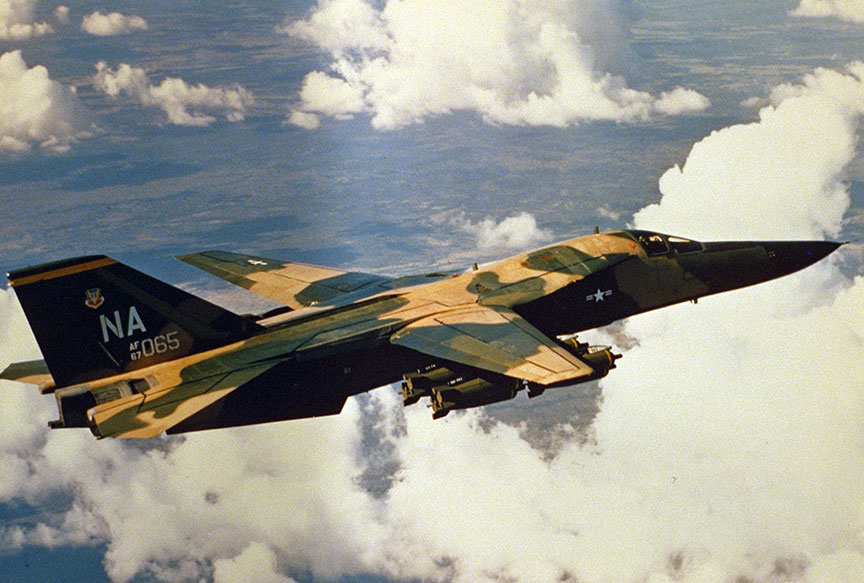F111- Aardvark

The versatile "swing wing" F-111 entered the Air Force inventory in 1967. The aircraft provided many firsts among weapons systems. It was the first production aircraft with variable swing wings that could be swept back or brought forward to increase efficiency. It also had the first terrain-following radar, allowing it to fly at night at high speeds and low altitudes, as well as the first crew escape module. The aircraft was one of the more controversial aircraft ever to fly, yet it achieved one of the safest operational records of any aircraft in USAF history.
The F-111 can exceed twice the speed of sound (Mach 2) by sweeping its wings rearward while in flight. The wings are swept forward for takeoffs, landings or slow speed flight. The two-person cockpit was also an advanced design module that served as an emergency escape vehicle and as a survival shelter on land or water.
During a 1972 - 1973 tour of duty in Vietnam, F-111As flew more than 4,000 combat missions. In 1986, the F-111F was used during El Dorado Canyon, the raid on Libya, and bombed five targets in retaliation for terrorist attacks. It also played a major role in the Persian Gulf War, flying more than 2,500 missions. The most notable was when two GBU-15 precision guided munitions were used to destroy the oil manifolds at the Al Almadi pumping station, effectively shutting down the Iraqi-made oil slick in the Persian Gulf and averting an environmental disaster.
Originally known as the TFX (Tactical Fighter Experimental), the F-111 was conceived to meet an Air Force requirement for a new tactical fighter-bomber. In 1960, the Department of Defense combined the Air Force's requirement with a Navy need for a new air superiority fighter, then launched a competition among aircraft manufacturers for the final design. In 1962, General Dynamics and Boeing were selected as finalists with the General Dynamics TFX design eventually winning out. The Navy version was known as the F-111B and the Air Force version the F-111A. Eventually the Navy's F-111B program was canceled.
The first flight of the F-111A took place in December 1964, and the first production models were delivered to the Air Force in 1967. In all, 566 F-111s of all series were built.The aircraft was produced in seven different variants until the last delivery in September 1976. The aircraft was unofficially nicknamed the Aardvark until its retirement ceremony July 27, 1996 where the name was made official.
General Characteristics
* Primary function: fighter
* Span: 32 feet swept; 63 feet extended
* Length: 73 feet 6 inches
* Height: 17 feet
* Weight: 92,657 lbs. max.
* Armament: One 20mm M61A1 gun, plus a mix of up to 24 conventional or nuclear weapons
* Engines: Two Pratt & Whitney TF30-P-3 of 18,500 pounds thrust each with afterburner
* Crew: Two
* Cost: $8.2 million
* Maximum speed: 1,452 mph
* Cruising speed: 685 mph
* Range: 3,632 miles
* Service ceiling: 57,000 feet
First Flight: 12/21/1964
 >
>